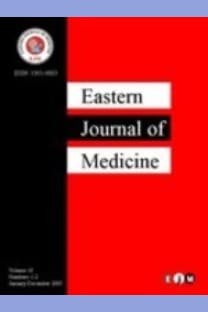Evaluation of Calcium Hydroxide Removal Efficiency of Different Concentrations and Forms of Sodium Hypochlorite
Evaluation of Calcium Hydroxide Removal Efficiency of Different Concentrations and Forms of Sodium Hypochlorite
___
- 1. Möller AJ, Fabricius L, Dahlén G, Sundqvist G, Happonen RP. Apical periodontitis development and bacterial response to endodontic treatment. Experimental root canal infections in monkeys with selected bacterial strains. Eur J Oral Sci 2004; 112: 207-15.
- 2. de Oliveira RL, Guerisoli DMZ, Duque JA, et al. Computed microtomography evaluation of calcium hydroxide-based root canal dressing removal from oval root canals by different methods of irrigation. Microsc Res Tech 2019; 82: 232-237.
- 3. Donnermeyer D, Wyrsch H, Burklein S, Schafer E. Removal of Calcium Hydroxide from Artificial Grooves in Straight Root Canals: Sonic Activation Using EDDY Versus Passive Ultrasonic Irrigation and XPendo Finisher. J Endod 2019; 45(3): 322-326.
- 4. Nandini S, Velmurugan N, Kandaswamy D. Removal efficiency of calcium hydroxide intracanal medicament with two calcium chelators: volumetric analysis using spiral CT, an in vitro study. J Endod 2006; 32: 1097-101.
- 5. Zorzin J, Wießner J, Wießner T, Lohbauer U, Petschelt A, Ebert J. Removal of Radioactively Marked Calcium Hydroxide from the Root Canal: Influence of Volume of Irrigation and Activation. J Endod 2016; 42(4): 637-640.
- 6. Ok E, Altunsoy M, Tanriver M, Capar ID. Effectiveness of different irrigation protocols on calcium hydroxide removal from simulated immature teeth after apexification. Acta Biomater Odontol Scand 2015; 1: 1-5.
- 7. Wang Y, Guo LY, Fang HZ, et al. An in vitro study on the efficacy of removing calcium hydroxide from curved root canal systems in root canal therapy. Int J Oral Sci 2017; 9: 110- 116.
- 8. Lambrianidis T, Kosti E, Boutsioukis C, Mazinis M. Removal efficacy of various calcium hydroxide/chlorhexidine medicaments from the root canal. Int Endod J 2006; 39: 55- 61.
- 9. Faria G, Viola KS, Coaguila-Llerena H, et al. Penetration of sodium hypochlorite into root canal dentine: effect of surfactants, gel form and passive ultrasonic irrigation. Int Endod J 2019; 52: 385-392.
- 10. Pontes F, Pontes H, Adachi P, Rodini C, Almeida D, Pinto D, Jr. Gingival and bone necrosis caused by accidental sodium hypochlorite injection instead of anaesthetic solution. Int Endod J 2008; 41: 267-270.
- 11. Zand V, Lotfi M, Rahimi S, Mokhtari H, Kazemi A, Sakhamanesh V. A comparative scanning electron microscopic investigation of the smear layer after the use of sodium hypochlorite gel and solution forms as root canal irrigants. J Endod 2010; 36: 1234-1237.
- 12. Garcia AJ, Kuga MC, Palma-Dibb RG, et al. Effect of sodium hypochlorite under several formulations on root canal dentin microhardness. J Investig Clin Dent 2013; 4: 229-232.
- 13. Calt S, Serper A. Dentinal tubule penetration of root canal sealers after root canal dressing with calcium hydroxide. J Endod 1999; 25: 431-433.
- 14. Bodrumlu E, Avsar A, Hazar Bodrumlu E, Cicek E. The effects of calcium hydroxide removal methods on bond strength of Epiphany SE with two irrigation protocols. Acta Odontol Scand 2013; 71: 989-993.
- 15. Faria G, Viola KS, Coaguila-Llerena H, et al. Penetration of sodium hypochlorite into root canal dentine: effect of surfactants, gel form and passive ultrasonic irrigation. Int Endod J 2019; 52: 385-392.
- 16. Goldsmith M, Gulabivala K, Knowles JC. The effect of sodium hypochlorite irrigant concentration on tooth surface strain. J Endod 2002; 28(8): 575-579.
- 17. Zehnder M, Kosicki D, Luder H, Sener B, Waltimo T. Tissue-dissolving capacity and antibacterial effect of buffered and unbuffered hypochlorite solutions. Oral Surg Oral Med Oral Pathol Oral Radiol Endod 2002; 94: 756- 762.
- 18. Baumgartner JC, Cuenin PR. Efficacy of several concentrations of sodium hypochlorite for root canal irrigation. J Endod 1992; 18: 605-612.
- 19. Ayhan H, Sultan N, Cirak M, Ruhi M, Bodur H. Antimicrobial effects of various endodontic irrigants on selected microorganisms. Int Endod J 1999; 32: 99- 102.
- 20. Siqueira JF, Jr., Rôças IN, Favieri A, Lima KC. Chemomechanical reduction of the bacterial population in the root canal after instrumentation and irrigation with 1%, 2.5%, and 5.25% sodium hypochlorite. J Endod 2000; 26: 331-334.
- 21. Türkün M, Gökay N, Özdemir N. Comparative investigation of the toxic and necrotic tissue-dissolving effects of different endodontic irrigants. İ Ü Diş Hek Fak Der. 1998; 32: 87-94. (in Turkish)
- 22. Gokturk H, Ozkocak I, Buyukgebiz F, Demir O. Effectiveness of various irrigation protocols for the removal of calcium hydroxide from artificial standardized grooves. J Appl Oral Sci 2017; 25: 290-298.
- 23. Rödig T, Hirschleb M, Zapf A, Hülsmann M. Comparison of ultrasonic irrigation and RinsEndo for the removal of calcium hydroxide and Ledermix paste from root canals. Int Endod J 2011; 44: 1155-1161.
- 24. Gu L-s, Kim JR, Ling J, Choi KK, Pashley DH, Tay FR. Review of contemporary irrigant agitation techniques and devices. J Endod 2009; 35: 791-804.
- ISSN: 1301-0883
- Yayın Aralığı: 4
- Başlangıç: 1996
- Yayıncı: ERBİL KARAMAN
Hanım Güler ŞAHİN, Selver KARAASLAN, Reyhan ORHUN, Nizamettin GÜNBATAR, Abdullah YEŞİLOVA, Cem Taylan ERDEN
Chee Ping CHONG, Shing Chyi LOO
Armin HOVEIDAEI, Mehrshad FEKRI, Amir HUMAN HOVEIDAEI
Examining Periodic Differences of Suicide Cases with Circular Data Analysis
Impact of the First Six Months of the Covid-19 Pandemic on Orthopedic and Hand Trauma Surgery
Cihan ADANAŞ, Sezai ÖZKAN, Tülin TÜRKÖZÜ, Necip GÜVEN, Abbas TOKYAY, Mehmet Ata GÖKALP, Mehmet Rauf KOÇ
The Effect of Age on Subfoveal Choroidal Thickness in Healthy Subjects
Kamil YAVUZER, Banu BOZKURT, Süleyman OKUDAN, Banu TURGUT ÖZTÜRK
Detection of Incidental Findings on Chest CT Scans in Patients with Suspected Covid-19 Pneumonia
Gökhan AYGÜN, Sercan ÖZKAÇMAZ, Fatma DURMAZ, Ramazan YILDIZ, Ensar TÜRKO, Saim TÜRKOĞLU, İlyas DÜNDAR, Leyla TURGUT ÇOBAN, Muhammed Bilal AKINCI
